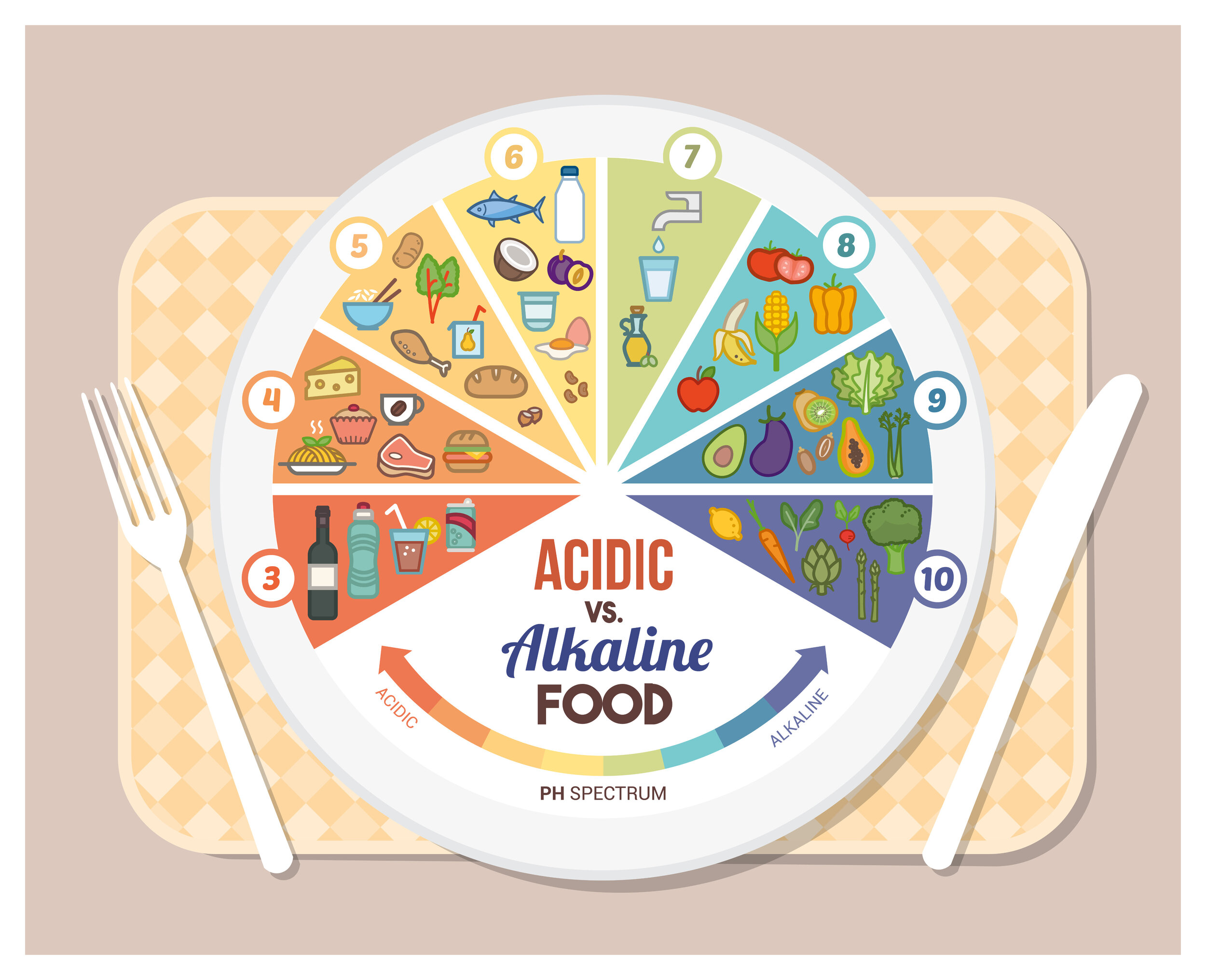Finding pH Balance
There are many reasons why a diet that focuses on whole foods can optimize health. First, eliminating processed foods, sugars, artificial ingredients and allergenic foods like gluten and dairy can reduce inflammation and all the health risks that come with it. Second, a whole foods diet that eliminates your allergenic foods better regulates your immune response and decreases your risk of autoimmune conditions. Additionally, this type of diet helps you get to and maintain a healthy weight. But what you may not realize is that a targeted whole foods diet also helps to balance your body’s pH levels.
Your Body’s pH
The term ‘pH’ stands for ‘potential of hydrogen,’ which is the measure of a solution’s hydrogen ion concentration. It is a measure of acidity or alkalinity on a scale of 0 to 14 – Zero being extremely acidic, 14 being extremely alkaline and 7 being neutral. When a solution is neutral it means there is complete balance between acid and alkaline. The human body tries to keep a tight range around neutral on the pH scale – between 6.8 (slightly acidic) and 7.4 (slightly alkaline). The most important thing to remember is that your blood pH needs to be maintained between 7.365 and 7.400. This is because blood needs to be slightly alkaline to nourish your tissues, organs and organ systems.
The foods you eat, the liquids you drink, your environment, your breathing patterns, and your exercise routine (or lack thereof) all have the potential to increase acidity in the body and negatively affect your blood pH. This happens because your body stores excess acid in your tissues which creates a more acidic body pH. To bring your body back into balance, your blood needs to pull from alkaline stores in your body – such as water, calcium, magnesium and potassium. To give you an example, the phosphoric acid in soda has a pH of 2.8. It is estimated to take roughly 32 glasses of pure water to neutralize the effects of one glass of soda!
All of your detoxification organs and systems – liver, kidneys, intestines, lungs and lymphatic system – help your body balance its pH. Of these, your kidneys are the major pH balancer. But if there is excess acidity that your kidneys can’t handle, bones and muscles can also suffer. If the body becomes overly acidic, calcium is withdrawn from your bones to neutralize that acidity. This can eventually weaken bones and lead to osteoporosis. Additionally, excessive acidity can pull glutamine from skeletal muscle to help restore the body’s pH. This can lead to difficulty gaining or even maintaining muscle mass.
If your diet, environment and lifestyle constantly keep your blood pH imbalanced, even a little bit, your body loses its effectiveness at neutralizing and eliminating those acid waste products from your system. This creates a chronic state of acidity in the tissues, increasing your risk of disease.
Acid-Alkaline Imbalance
Common early signs of acid-alkaline imbalance include: allergies, breathing disorders, chronic colds and flus, headaches, indigestion, inflammation, fatigue, muscle cramping, pain, skin troubles and sinus problems. As acid continues to accumulate in the body, several organs and glands become effected including your thyroid, adrenal glands and liver. This can lead to many other health conditions. In fact, research has linked the following diseases and conditions to an underlying pH imbalance:
Allergies
Alzheimer’s disease
Arteriosclerosis
Arthritis
Bone fractures
Bronchitis
Cancer
Candida overgrowth
Cardiovascular disease
Chronic fatigue syndrome
Chronic infections
Dementia
Depression
Diabetes
Fibromyalgia
Heart attacks
High blood pressure
High cholesterol
Hormonal imbalances
Immune deficiencies
Insulin sensitivity
Kidney disease
Lou Gehrig’s disease
Multiple sclerosis
Muscular dystrophy
Obesity
Osteoarthritis
Osteoporosis
Parkinson’s disease
Premature aging
Premature hair graying
Prostate problems
Senility
Sinusitis
Stroke
Tooth decay and loss of teeth
Weight problems
If you have any of the following conditions above, you may have an acid-alkaline imbalance.
Causes of Acid-Alkaline Imbalance
There are several lifestyle and nutrition choices that could be increasing acidity in your body. Here are the top five categories:
Stress. If your body is frequently in ‘fight or flight’ mode, your body is constantly secreting stress hormones. This not only creates inflammation in the body, it also increases acidity.
Shallow breathing. Chronic stress also leads to rapid and shallow breathing or even holding your breath. Oxygen alkalizes your blood so reduced oxygen intake from this type of breathing pattern can increase acidity in the body.
Toxins. Pesticides and other chemicals in conventional produce and meats; heavy metals; industrial pollutants; hormones and other chemicals found in foods, plastics, cleaning supplies and beauty products; and even potential chemicals in your tap water all increase acidity in the body.
Infections. Infections create a more acidic environment which, in turn, makes you more vulnerable to germs leading to a vicious cycle.
Acidic Diet. Sugar, refined flours, food additives, table salt, trans fats, fried foods, meat, dairy, alcohol and caffeine make it difficult for your body to restore its pH balance.
Get Back Into pH Balance
Use the following tips to decrease acidity in your body, reduce risk of diseases and optimize health.
Reduce or Eliminate harmful acidic foods from your diet.
Sugar. Sugar not only throws your pH levels out of balance, but excessive sugar consumption creates the perfect environment for overgrowth of yeast, fungi and pathogenic bacteria which can compromise health.
Refined Flours. White flour, all baked goods made from refined flours (including some “multigrain” and “wheat” breads), and white rice are acid-forming in the body.
Food Additives. Artificial flavors, colors, sweeteners and preservatives are not only acid-forming in the body, but many also have neurotoxic effects.
Table Salt. Your average table salt is acid-forming. However, the good news is that sea salt, especially Celtic and Himalayan, are alkalizing on the body. This is because they contain an alkalizing form of sodium as well as other minerals like potassium and calcium which help combat acidity in the body.
Unhealthy Fats. Trans fats and rancid fats from fried foods are both acid-forming in the body.
Processed Foods. Packaged and processed fast foods have most if not all of the ingredients above - sugar, refined flour, food additives, salt, and unhealthy fats.
Meats and Dairy. Almost all animal products are highly acid-forming, including beef, veal, pork, bacon, luncheon meats, eggs, milk, cheese, organ meats, poultry, farm-raised fish and shellfish. Cutting back on your consumption of these foods, and switching to organic, grass-fed, free range options will make it easier to balance your pH.
Alcohol. Alcohol is highly acid-forming in the body. In addition to alcohol’s high sugar content, the ethanol in alcohol converts to acetaldehyde, a toxic by-product that also occurs in car emissions, tobacco smoke and industrial processes.
Caffeine. Excessive caffeine consumption can increase acidity in the body.
Certain Fruits, Vegetables and Nuts. Canned fruit, fruit syrups, fruit juices, jams, jellies, mushrooms, white potatoes, and salted nuts all increase acidity in the body.
Choose healthier acidic foods.
Having a 100% alkaline diet is not healthy either. Again, it’s about balance. So choose healthier options for acidic foods and keep them at a low level in your diet – approximately 30%.
Choose organic, grass-fed, free range and wild caught for meats, poultry and fish.
Fresh Fruits. Yes, fruits can be acidic in the body. But they are full of fiber, vitamins, antioxidants and phytonutrients so they should still be a part of a whole foods diet. Just limit your consumption to fresh, organic fruits and eat more veggies than fruit.
Black beans, kidney beans and chickpeas. Again, although these specific beans may be more acidic, they are still a good option for your whole food meal plan.
Oats, brown rice, wild rice, amaranth and millet. All grains are acidic, but these are less acidic than wheat and refined flours.
Raw, unsalted nuts and seeds.
Cold-pressed and/or virgin oils.
Honey and maple syrup. These are still sugars, but can be part of an alkalizing diet in small quantities.
Increase alkaline foods to 70% of your diet.
All vegetables. Especially when organic and raw, veggies are very alkalizing.
Yams, sweet potatoes, turnips, rutabaga, jicama, taro root, onion, kohlrabi, parsnips, beets and other root crops. These help quickly alkalize the body.
Legumes. Organic soybeans, lentils, and lima beans help reduce acidity in the body.
Avocados, coconut, lemon, lime, grapefruit, tomatoes and sour cherries. These fruits (yes avocados and tomatoes are fruits!) are very alkalizing to the body.
Buckwheat groats and quinoa. These “grains” are not really grains at all, but seeds. They not only have complete proteins but also help reduce acidity.
Almonds, pumpkin seeds, sesame seeds and sprouted seeds. Almonds and almond milk are very alkaline as are sprouted seeds.
Avocado oil, coconut oil, flaxseed oil, olive oil and fish oil. Healthy oils can be a part of an alkalizing diet.
Peppermint tea, yerba mate tea and lemon water. These beverages help to combat acidity in the body.
Incorporate alkalizing lifestyle choices.
Any activities that reduce your stress load, decrease your exposure to toxins and/or get you to breathe deeper will reduce acidity in the body.
Exercise. Moving and sweating helps remove acidic waste from the body as well as improve your breathing patterns.
Yoga. Yoga not only helps with flexibility and stress management, but it increases your practice of deep breathing.
Deep Breathing. Research shows that setting aside even 30 seconds for purposeful deep breathing exercises has a profound effect on acidity in the body.
Meditation. This effective stress management tool can also help with reducing acidity in the body.
Massage Therapy. Massage is a great stress reducer and some techniques can even help with lymphatic drainage.
Dry Brushing. This is a simple way to stimulate your lymphatic system. This promotes circulation of blood and lymph fluid to help remove acidic waste.
You could also consider alkalizing supplements such as chlorella, digestive enzymes, bromelain, essential fatty acids, a high quality multivitamin and B complex.
As you can see, there are many reasons to switch to a more whole foods and less processed foods diet. Finding the balance, including the pH balance, is an important piece to optimizing your health!
RESOURCES
The Acid Alkaline Food Guide, 2nd Ed. Dr. Susan E. Brown
The Ultimate pH Solution, Michlle Schoffro Cook, DNM, DAc
https://draxe.com/alkaline-diet/

